

|
|
.. resources to create and apply insights November 2024 .. marketing to the right demographic might be improved by using up-to-date measures for county population by age. The following graphic shows patterns of 2023 median age by county. The median age ranged from 20.9 (Madison, ID) to 68.0 (Sumter, FL). 
What about the market segment "females age 15-19 years" for reaching a young women's magazine by county? This and related measures are part of the same data resource used to develop the above graphic. Use the iVDA/VDAGIS Discovery resource to dynamically examine the patterns. Compare how the methods being used now to using these data. Contact us for more information. More generally .. the largest U.S. county based on population is Los Angeles County, CA (9.7 million) .. 48 counties have more than 1 million population. Approximately 60% (1,876) of U.S. counties gained population from 2022 to 2023, an increase from the 52% of counties (1,649) that experienced population growth between 2021 and 2022. Among the nation's 3,144 counties, the average change from 2022 to 2023 was 0.29%, up from 0.17% the previous year. What about your counties of interest? Find out. Use the interactive table below to view, rank, sort, compare county, and county by state, population and components of change since 2020. How & Why County Population is Changing .. 2020-2023 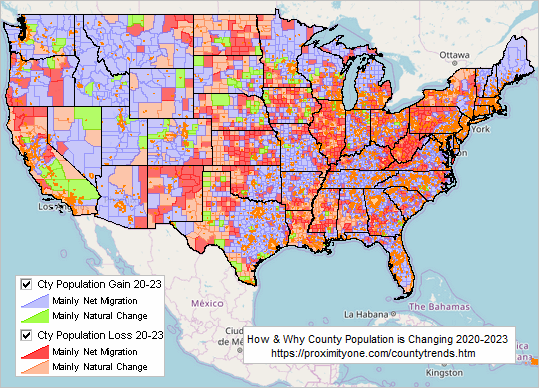
For many counties the pandemic has impacted each component of population change: births, deaths and migration. The pandemic among other factors including climate change impact different counties in different ways. Learn more. Find out more about county demographic change projected to 2030 and 2060. See more below about annual 2010 to 2020 county intercensal estimates of population and components of change. Vintage 2024 Estimates and Projections to 2030 The following sub-section provides an update on Census bureau U.S. by county Vintage 2023 model-based estimates of population and components of change (2020 through 2023) .. data released 3/14/24.
How & Why County Population Has Changed 2020-2023
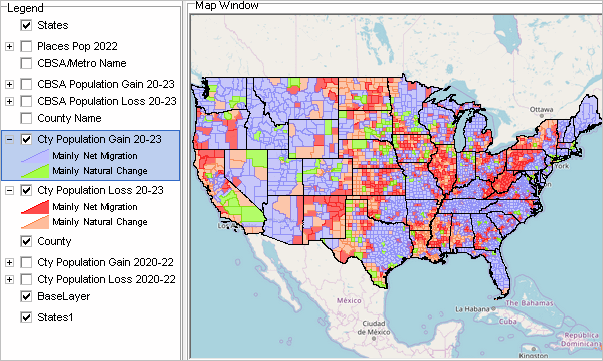
ProximityOne has used these and related data to develop annual projections, 2024 through 2030, of the same subject matter items for counties. Click links below to view the profile for counties of interest. These model based projections reflect one scenario .. that population components of change follow the same patterns as reflected by recent estimates. Selected County Profiles - Fresno County, CA - Orange County, CA - Los Angeles County, CA - Harris County, TX - Clark County, NV - Washoe County, NV - Sedgwick County, KS - Alexandria, VA - Fairfax County, VA County/Regional Mapping & GeoStatistical Analysis using VDA Web GIS 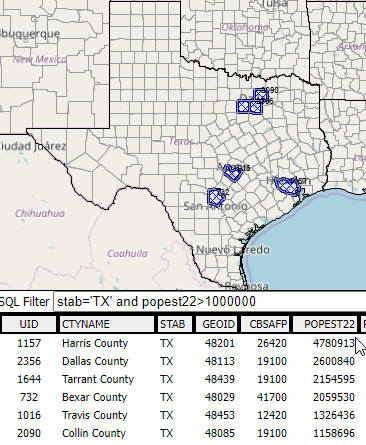 The CountyTrends GIS
project can be used with the VDA Web GIS for
county/regional mapping and geospatial analysis.
For example, a query (stab='TX' and popest22>1000000) is used to show all Texas counties with 2022 population 1,000,000 or more in a table
sorted on 2022 population in descending order (popest22 desc). Then, the show-selected button is clicked to show selected counties in map winodw --
as shown in graohic at right.
Click graphic for larger view. Step-by-step how-to instructions below.
The CountyTrends GIS
project can be used with the VDA Web GIS for
county/regional mapping and geospatial analysis.
For example, a query (stab='TX' and popest22>1000000) is used to show all Texas counties with 2022 population 1,000,000 or more in a table
sorted on 2022 population in descending order (popest22 desc). Then, the show-selected button is clicked to show selected counties in map winodw --
as shown in graohic at right.
Click graphic for larger view. Step-by-step how-to instructions below.Examining County GeoStatistical Characteristics & Patterns Counties, and county equivalent areas such as independent cities, are the primary political subdivision of states. The relative stable geography of counties, with good national scope geographic granularity, makes these areas appealing for use in tabulating data and analyzing demographic-economic data. This section provides information on tools and data related to accessing, integrating analyzing county demographic-economic patterns and trends. .. updates ,, interactive table Patterns of Percent Net Migration by County: 2021-2022 The following graphic shows patterns of percent net migration by county for the two-year period 7/1/20 to 6/30/22. See details below about how these data were computed. The largest ten metros (MSAs) are highlighted with bold black boundaries.  - click graphic for larger view and details. - the above view, and interactive variants, may be viewed using the CountyTrends GIS project with the VDA Web GIS. Join us in the weekly data analytics web sessions where CountyTrends topics are always included. Population & Components of Change Total population for an area can be computed as a sum of components of change: Population (7/1/23) = Population (7/1/22) + Births (6/30/22 to 7/1/23) - Deaths (6/30/22 to 7/1/23) + Net International Migration (6/30/22 to 7/1/23) + Net Domestic Migration (6/30/22 to 7/1/23) How & Why Counties are Changing .. goto top The following graphic shows how a county is changing (layers for gaining or losing population) and why a county is changing (interval for mainly net migration and interval for mainly natural change) for the period 4/1/20 - 6/30/23. The largest ten metros (MSAs) are highlighted with bold black boundaries. 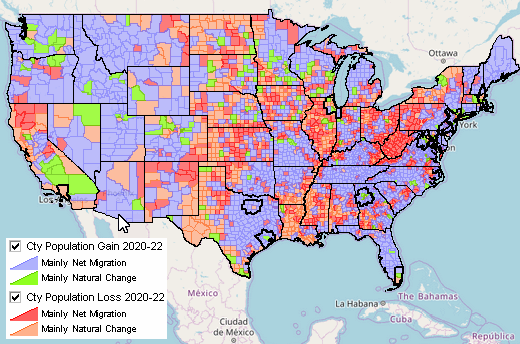 - click graphic for larger view and details. - the above view, and interactive variants, may be viewed using the CountyTrends GIS project with the VDA Web GIS. For example, the computation to determine "gaining, mainly natural change" (green) is: (popest22-popest20)>0 and (netmig20+netmig21+netmig22)<=(natchg20+natchg21+natchg22) .. the determination for Harris County, TX is: (4780913-4734505)>0 and (-5261 + -26615 + 17262 )<=( 7446 + 26061 + 30117) or (46408)>0 and ((-14614)< (63624)) 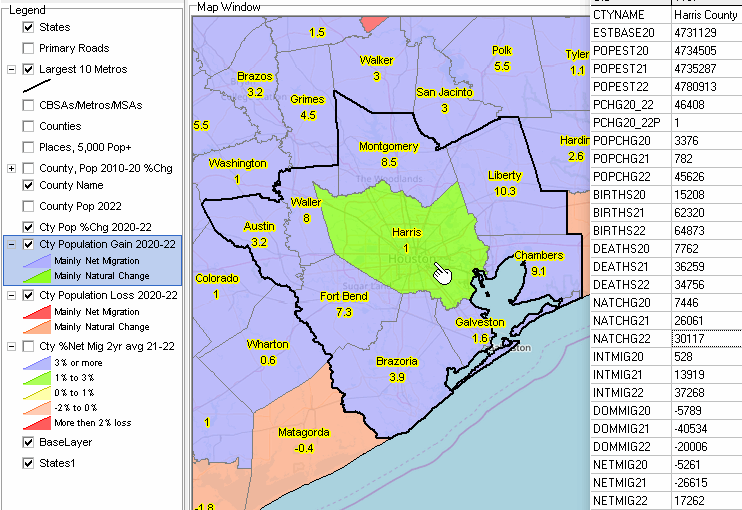 - click graphic for larger view and details. Selected County Geographic-Demographic-Economic Updates .. goto top ... scroll section
Outlook 2060: U.S. Demographic-Economic Projections to 2060
.. Annual projections 2010 to 2060 .. U.S., state, county population by single year of age, gender, race, origin with associated multi-sector economic projections. .. http://proximityone.com/demographic2060.htm 04.03.23. This section extensively updated using Census Bureau county model-based population estimates. .. annual updates released in March 2023. State-County Population & Components of Change 2020-2023 Interactive table goto top Click column header to sort; again to sort other direction. Click ShowAll/Reset button between queries to refresh table. Usage notes below table. Interactive Table Usage Notes Operations • Click ShowAll between queries/filters. • Use left-most column to select by state. • Find in Name button; click ShowAll button first .. click Find in Name button to search column 1 for text in edit box. .. text entered in edit box is case sensitive. .. partial names are okay to use. .. click with default value to view all rows with "Harris" (no quotes) • State-County FIPS Codes: http://proximityone.com/stcty.txt Selected columns buttons • Pop - click to view population columns. • NetChg - click to view net Migration columns. • Births - click to view births columns. • Deaths - click to view deaths columns. • NatInc - click to view natural increase columns. • IntMig - click to view international migration columns. • DomMig - click to view domestic migration columns. • NetMig - click to view net migration columns. • Population Min & Max> button .. click to show only peer group counties based on values in min and max edit boxes. .. enter the minimum 2022 population in the left edit box. .. enter the maximum 2022 population in the right edit box. • Click ShowAll between queries/filters. Items in Table - Areaname - St - StCty - Type - Population 2020 - Population 2021 - Population 2022 - Population 2023 - Population Migration 2020-23 - Population %Migration 2020-23 - Births 2021 - Births 2022 - Births 2023 - Deaths 2021 - Deaths 2022 - Deaths 2023 - Natural Migration 2021 - Natural Migration 2022 - Natural Migration 2023 - Int'l Migration 2021 - Int'l Migration 2022 - Int'l Migration 2023 - Domestic Migration 2021 - Domestic Migration 2022 - Domestic Migration 2023 - Net Migration 2021 - Net Migration 2022 - Net Migration 2023 - Residual 2021 - Residual 2022 - Residual 2023 - Group Quarters 2020 - Group Quarters 2021 - Group Quarters 2022 - Group Quarters 2023 County/Regional Mapping & GeoStatistical Analysis using VDA Web GIS .. goto top From above ... The CountyTrends GIS project can be used with the VDA Web GIS for county/regional mapping and geospatial analysis. In this example, a query (stab='TX' and popest22>1000000) is used to show all Texas counties with 2022 population 1,000,000 or more in a table sorted on 2022 population in descending order (popest22 desc). Then, click show selected to get the result shown below.  The steps to perform this application are as follows. Using any browser (Chrome recommended) and any device (Windows desktop/laptop recommended) ... Start VDA Web GIS .. sbout VDA Web GIS .. VDA GIS Getting Started Select CountyTrends in the Select Project form. When map window displays, in Legend panel at left .. - uncheck Largest 10 Metros, - uncheck Cty %NetMig ... - check on Counties Click Query/Table button, below map window, far right. Click Select Field button below table. Then check: CTYNAME, STAB, GEOID, CBSAFP, POPEST22. Then click "Set & Close" button. In SQL Filter edit box, key in "stab='TX' and popest22>1000000" (no double quotes) In SORT edit box, key in "popest22 desc" (no double quotes) Click Query button at right of SORT edit box. .. table refreshes, with table content as shown in above graphic. Click "Highlight all that meet query button" at right below table/ .. map window shows selected counties with cross-hatch pattern. Zoom to state so all selected counties show in map. Done! More .. click on a county to view its data profile. .. the profile shows in lower left panel. Click the HTML button below the lower left panel to display an HTML page showing the attributes. CountyTrends GIS Project & Datasets .. goto top The CountyTrends GIS project is a frequently updated, ready-to-use GIS project with CV XE GIS and all VDA GIS tools. How & Why Atlanta Metro County Population is Changing .. 2020-2023 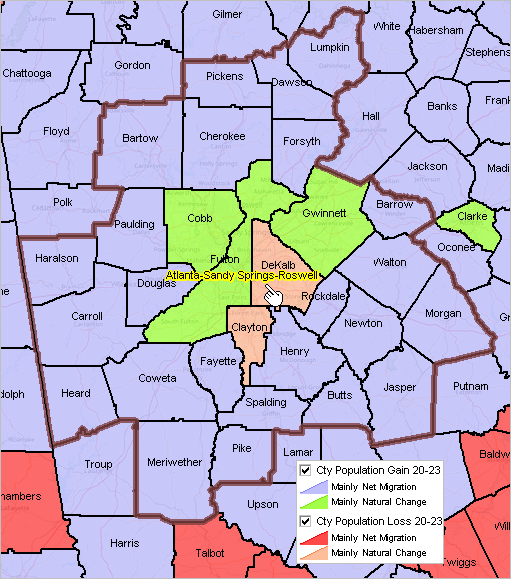
County Population Projections .. 2021-2030 
Layers included in the CountyTrends GIS project States Interstate Urban Area - Census 2020 urban areas Places Marker Places Boundary Places Pop 2022 CBSA/MSA - 2023 vintage 925 Core-Based Statistical Areas - includes vintage 2023 population and components of change estimates County Boundary - vintage 2023 population and components of change estimates County Boundary Bold - vintage 2023 population and components of change estimates County Name - vintage 2023 population and components of change estimates County HomeCtr Estabs - 20Q2 & 20Q3 QCEW Home Center Establishment Characteristics - integrates data downloaded using DEDE - updated quarterly - uses NAICS 44411; e.g., Lowes, Home Depot - choose different NAICS code Cty %PopChg 2021-2030
County projections are contained in the layer “Cty %PopChg 2021-2030” and corresponding shapefile.
There are projections for six years for each county (U.S. 3,144 counties).
The term population projection as used here refers to population data developed for periods/years into the future.
We cannot of course know these data values and make assumptions and use methods to develop the projections.
As a result many projections can be developed and their values depend on the assumptions and methodology. Any particular set of projections may be incorrect.
For these projections, a generic model has been used/applied to all counties. The projections are developed using each component of annual change for births, deaths and migration, then using the population identity P[t] = P[t-1] + B[t-1,t] -D[t-1,t] + M[t-1,t] .. P: population, B:Births, D:Deaths. M:net migration to determine the annual (t) population projection. Assumptions include that the “behavior” of each item B. D, M continue to follow recent observed historical trends throughout the projection period that there are no exceptional factors that occur (recession, pandemic, environmental event, etc.) during the projection period. County Pop & $MHI - vintage 2023 population and components of change estimate - POPEST22>=50000 and mhi22>=75000 - user settable query to show counties meeting selected criteria County $MHI - ACS 2022 itemsset1 items - user settable label -- defaults to median household income - includes ACS 2022 itemset1 County %PopChg 20-23 - vintage 2023 population and components of change estimate - user settable label -- defaults to percent population change 2020-23 Cty Population Gain 20-23 - vintage 2023 population and components of change estimate - designed to be used with "Loss" layer below Cty Population Loss 20-23 - vintage 2023 population and components of change estimate - designed to be used with "Gsin" layer above BaseLayer - topographic layer - the only that is not local to the computer where project is installed. - requires Internet States1 - states base layer Additional Information ProximityOne develops geographic-demographic-economic data and analytical tools and helps organizations knit together and use diverse data in a decision-making and analytical framework. We develop custom demographic/economic estimates and projections, develop geographic and geocoded address files, and assist with impact and geospatial analyses. Wide-ranging organizations use our tools (software, data, methodologies) to analyze their own data integrated with other data. Follow ProximityOne on Twitter at www.twitter.com/proximityone. Contact us (888-364-7656) with questions about data covered in this section or to discuss custom estimates, projections or analyses for your areas of interest. |
|
|